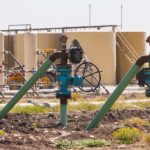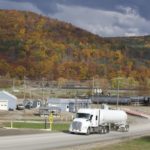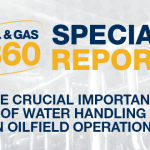Special Report From the Carlsbad Current-Argus
In New Mexico, hydraulic fracturing taxes a resource perpetually scarce in the desert region: water.
Hydraulic fracturing, or fracking as it is commonly called, blasts vast amounts of water, sand and chemicals through underground pipes to crack open the underground rock formations that hold crude oil and natural gas.
A barrel of oil, or about 42 gallons, yields about half a barrel of wastewater.
As production grows, the challenge of what do with the wastewater created by fracking means exploring solutions as big as the boom itself.
Baker Hughes, an oil and gas service company and authority on industry data, reported a record-breaking rig count of about 103 in New Mexico in 2018 — mostly in the Permian Basin, where the U.S. Geological Survey (USGS) said the “largest continual” oil and gas resource was discovered.
Fracking has been the subject of much debate. But before your form an opinion on the subject, first consider the process.
An increasing water footprint
A 2018 study conducted by Duke University titled “The Intensification of the Water Footprint of Hydraulic Fracturing,” reported the fresh water used nationally in fracking increased to 770 percent from 2011 to 2016, while wastewater volumes within the first year of production grew by 550 percent.
In the Permian Basin, production showed the greatest increase of any basin, 290 percent from 2011 to 2016, according to the study.[contextly_sidebar id=”edzBrCGf6fXGL8xDmQWDXdCszavVhjKP”]
“The steady increase of the water footprint of hydraulic fracturing with time implies that future unconventional oil and gas operations will require larger volumes of water for hydraulic fracturing, which will result in larger produced oil and gas wastewater volumes.”
A previous study titled “How Much Water Does U.S. Fracking Really Use?” from Duke in 2015 revealed that energy companies used up to 250 billion gallons of water between 2005 and 2014 for these “unconventional drilling” processes across the U.S., creating 210 billion gallons of wastewater.
One fracked well could use up to 6 million gallons of water, the study estimated, and “thousands” are drilled each year.
The 2018 study also predicted that cumulative water usage in unconventional gas producing regions would grow up to 20 times, and up to 13 times in oil-producing regions from 2018 to 2030.
“The steady increase of the water footprint of hydraulic fracturing with time implies that future unconventional oil and gas operations will require larger volumes of water for hydraulic fracturing, which will result in larger produced oil and gas wastewater volumes,” the study notes.
Communities in the Permian and the Eagle Ford Basin in south Texas could be dramatically impacted by the water usage, according to the study, as water is scarce in the desert regions and increasing volumes of water usage put even more demands on the resource.
“The predicted increasing water use, and flowback and produced water production in the Permian and Eagle Ford basins are alarming given the extreme water scarcity in these regions,” read the study.
As of 2016, there are 977,000 wells in the U.S. according to the federal Energy Information Administration. Of those wells, 670,000— or 69 percent — were drilled using hydraulic fracturing.
The study incorporated data from the EIA, along with state agency and industry reports on 10 major oil-producing basins in the U.S.
Wastewater can also come from traditional wells, as crude oil often brings water with it to the surface, high in brine and other chemicals.
Eighty-four percent of the water used in fracking became waste that has historically been pumped back into the ground in disposal wells.
During what industry leaders are calling an “unprecedented” boom in the Permian Basin, the scale of the wastewater is only now being understood, wrote Avner Vengosh, geochemistry professor of water quality at Duke’s Nicholas School of the Environment and author of both studies.
“Water use and wastewater production are two of the chief environmental concerns voiced about hydraulic fracturing,” Vengosh wrote in the study. “Yet until now we’ve had only a fragmented and incomplete understanding of how much water is actually being used, and how much wastewater is being produced.”
As more is understood about the scale of the problem, the oil and gas industry’s attention has become focused on solutions beyond traditional disposal wells, including recycling and reuse.
No. 1 priority
Ryan Flynn, executive director of the New Mexico Oil and Gas Association, a trade group representing up to 900 oil and gas operators in New Mexico, said water reuse is the industry’s “No. 1” priority, as fresh water becomes scarce, and the industry looks to cut back on its environmental impact.
He said the industry hopes to get “as close as possible” to 100 percent recycled water in the next decade.
“Just the sheer volume of production is making the reuse and recycling of water even more economical,” Flynn said. “It’s driving the cost down. And the cost of freshwater is going up.
“I think this is necessary. There’s the environmental need. The aquifer depletion is No. 1 and the cost is No. 2.”
Vengosh said the oil and gas industry is mostly motivated by the economics of recycling water as necessary to sustain its growth.
“Definitely, it’s the economic incentive,” he said. “If they don’t have any water in the Permian and they need it to drill or conduct fracking, they will find a solution. At the end of the day for them it’s the cost benefit. It’s all economics.”
What is happening now?
The most recent oil and gas boom in New Mexico and west Texas began in the middle of 2017 as prices began to recover from a bust in 2016 when they plummeted from $120 to about $30 per barrel.
In May, 2019, prices hovered around $60 to $65, per data from NASDAQ.
In November 2018, the USGS identified 46.3 billion barrels of oil, 281 trillion cubic feet of natural gas and 20 billion barrels of natural gas liquids in Texas and New Mexico’s Wolfcamp Shale and Bone Spring Formation, both in the heart of the Permian.
To extract the resources from the previously unreachable formations, operators used hydraulic fracturing fueling a boom that is estimated to last for 15 years.
Experts estimated one unconventional, horizontal frack well matches the production of up to 20 traditional vertical wells.
Injected watewater into disposal wells after crude oil and natural gas liquids are extracted could put aquifers which supply drinking water at risk of contamination.
Seismic activity could also increase, read a 2018 report from Energy In-depth, a project of the Independent Petroleum Association of America.
A 1966 report from the Stanford University School of Earth, Energy and Environmental Sciences detailed how a disposal well drilled in the Denver area, within years caused 710 earthquakes in a region that had not felt seismicity since 1882.
There are 40,000 wells used for commercial disposal of wastewater from oil and gas production across the U.S., per 2018 data from the USGS.
The wastewater is injected thousands of feet underground into rock formations, often a mile or more below drinking water sources, read the Association’s study.
“There’s this potential new source of water that can be used in other applications beyond the oil and gas industry.”
Flynn said modern-day technology allows operators to place disposal wells in areas of little seismic activity, and it is a safe process that will likely continue.
“I think using disposal wells makes sense from an environmental perspective. We’re re-injecting that water. It’s a waste product when we’re done using it, so we’re putting it in the safest place to put it, which is right back into the same formation from which we have extracted it,” Flynn said.
The U.S. Environmental Protection Agency began regulating disposal wells in the mid-1970s, following passage of the Safe Water Drinking Act, but widespread use of such activity began in the 1930s.
The practice can be safe, Flynn said, as long as operators use “best practices” and avoid sensitive formations.
Still, he said the industry has an opportunity growing in step with the boom: to create an economy for use of treated and recycled water in agriculture and other industries.
“There’s this potential new source of water that can be used in other applications beyond the oil and gas industry,” Flynn said.
Waste to water
The focus on recycling or reusing wastewater recently gained momentum, Flynn said, as freshwater began to run out in the nation-spanning Ogallala — an underground aquifer that sits under eight states from South Dakota to Texas.
“What we’re seeing now is there is a major environmental need, certainly in terms of water management and conservation in southeastern New Mexico and the Ogallala Aquifer.”
He said the next five years could see billions of industry dollars invested in what Flynn called the “water midstream sector,” an emerging area in oil and gas whose focus is to recycle and reuse wastewater.[contextly_sidebar id=”gVNP3ai5WWMjyEF5w01AUgTKB2DZ6eGc”]
“I don’t think industry has been ignoring the issue. I think industry has been investing pretty heavily in conservation,” Flynn said. “What we’re seeing now is there is a major environmental need, certainly in terms of water management and conservation in southeastern New Mexico and the Ogallala Aquifer.
“We’ve been doing it, but it’s becoming critical in light of some of the stress that’s being put on groundwater resources in the region.”
Water scarcity in New Mexico also drove up the cost of freshwater, he said, making reuse and recycling “critical” to sustain the industry’s recent growth.
“It’s just the cost of freshwater has increased, and the ability of being able to reuse produced water in our frac jobs is actually much more economical, especially when you’re producing at the scale that we’re producing now,” Flynn said.
“It’s not that we haven’t had the technology. The technology to treat water, we’ve had that. It’s being able to move water around people’s drilling operations in a way that allows them to manage their development plans in a pretty organized, almost manufacturing approach.”
Fracking could also pose a risk to local water supplies, especially in drought-prone regions of the American West, read the report.
“Finding ways to treat and dispose of or recycle the large volume of chemical-laden flowback water and brine-laden wastewater that is produced over the lifetime of an unconventional oil or gas well also poses challenges,” Vengosh wrote in the study.
NM revenue: Oil and gas brings $2.2 billion to NM while lawmakers debate regulation
“Given the high levels of contaminants these waters contain, it’s startling that the amount of wastewater being produced from hydraulic fracturing in the United States is nearly on the same level as the amount of water used to frack the wells in the first place.”
Vengosh said the challenges with recycling water can vary by region as differing geology alters the water’s chemistry.
“The main issues are what’s in the chemistry of the wastewater,” he said. “The issue is the salt. The high level of salt. The high level of salt that can precipitate once they are moving or changing or managing. That’s kind of the challenge the industry is working with wastewater for recycle for fracking.”
Political pressure
Newly-elected Democrat Gov. Michelle Lunjan Grisham’s administration is focused on addressing environmental issues and strengthening regulations amid the boom.
She signed several bills into law resulting from the a recent 60-day legislative session in New Mexico, which ran from January to March.
Concerns about wastewater – or “produced water” in industry terms – were met with House Bill 546, also known as the Fluid Oil and Gas Waste Act.
The Act gave enforcement authority to the State of New Mexico’s Energy, Minerals and Natural Resources Department (EMNRD), and subsidiary the Oil Conservation Division (OCD) on regulations for produced water and spills in the oil and gas industry.
HB 546 required the well owners and producers to take ownership of wastewater, and be responsible for its disposal or transfer, and required State permitting for its use in operations.
The law specified fines and prison terms as consequences of noncompliance.
A report on violations would be made each October, per the bill, specifying the number of violations and amount of penalties assessed.
“This bill is New Mexico’s first major oil and gas legislative reform in over a decade and is a testament to the strong health and safety policies being championed by Gov. Lujan Grisham,” said Jon Goldstein, director of regulatory and legislative affairs for energy at the Environmental Defense Fund – a national non-profit advocating for environmental issues.
Flynn said crafting the Produced Water Act actually began during the term of Lujan Grisham’s predecessor former-Gov. Susana Martinez, who Flynn served as NMED cabinet secretary from 2013 to 2016.
The bill enjoyed bipartisan support and was promoted by the industry and environmentalists alike – groups that rarely agree on anything, Flynn said.
“At the last legislative session, you had some of the most progressive members of our state legislature and some of the most conservative all jumping behind the Produced Water Act, which I think is pretty amazing,” Flynn said.
“You had people voting together who never vote together on any issues.”






